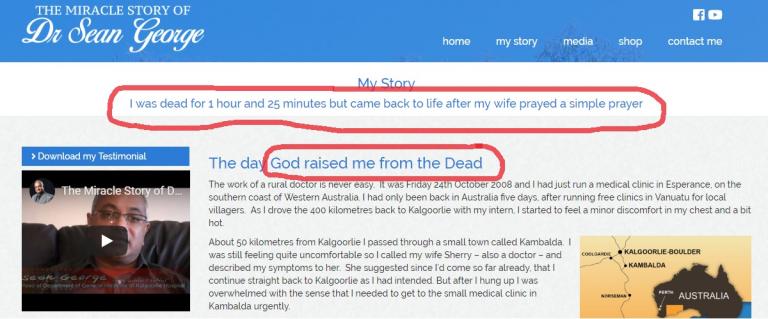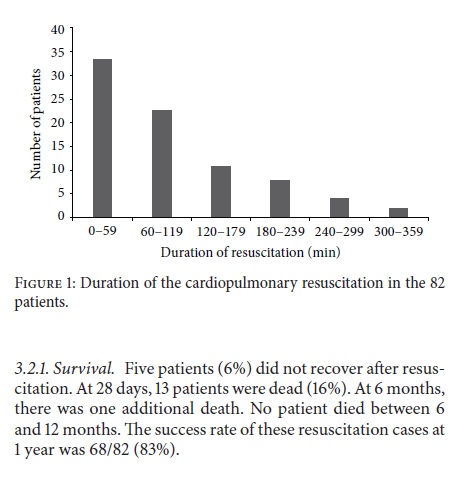The Resurrection of Dr. Sean George – Part 3: George’s Argument
Dr. Sean George implies a miracle claim in the title of his main online article:
The day God raised me from the Dead
The miracle claim that this title clearly implies is this:
God raised me from the dead.
To make this claim clear, we need to replace the personal pronoun “me” with its intended referent:
God raised Dr. Sean George from the dead.
At the top of the web page just above the title of the article, is a related but somewhat different statement:
I was dead for 1 hour and 25 minutes but came back to life after my wife prayed a simple prayer
We can clarify this claim by replacing the personal pronoun “I” with its intended referent:
Dr. Sean George was dead for 1 hour and 25 minutes but came back to life after Dr. Sean George’s wife prayed a simple prayer.
This claim also has a clear implication:
Dr. Sean George rose from the dead.
It seems to me that that this implied claim is a REASON given in support of the claim implied in the title of his article. So, we have a simple little argument that is implied by the title and the heading above the title:
1. Dr. Sean George rose from the dead.
THEREFORE:
2. God raised Dr. Sean George from the dead.
As it stands, this argument is logically INVALID. Claim (2) does NOT logically follow from claim (1). However, there is a belief about God held by many Christians that would work nicely to fill the logical gap in this argument:
1. Dr. Sean George rose from the dead.
A. Only God can cause a person to rise from the dead.
THEREFORE:
2. God raised Dr. Sean George from the dead.
Is this a solid argument for claim (2)?
The first problem I see with this argument is that the meanings of the premises are UNCLEAR. Before we can rationally evaluate this argument, we need to understand the meanings of the premises (1) and (A). The problematic phrases are “rose from the dead” in premise (1), and “rise from the dead” in premise (A).
The basic meaning of this phrase is that a person who has died, becomes alive again. This meaning is implied in the statement that appears in the header above the title of Dr. Sean George’s article:
I was dead for 1 hour and 25 minutes but came back to life after my wife prayed a simple prayer
But what does it mean to be “dead for 1 hour and 25 minutes”? It is clear that Dr. Sean George means that he was CLINICALLY DEAD (i.e. in a state of cardiac arrest) for that period of time. We can see that in the following statement from the article in question:
There aren’t many well documented cases of patients being clinically dead for so long… (emphasis added)
So, Dr. Sean George claims to have been clinically dead for a period of time and that after that he came back to life. We can now clarify the above argument, so that it can be rationally evaluated:
1a. Dr. Sean George was clinically dead for a period of time and then he came back to life.
A1. Only God can cause a person who was clinically dead for a period of time to come back to life.
THEREFORE:
2a. Dr. Sean George was clinically dead for a period of time and then God caused him to come back to life.
This argument is clearly UNSOUND, because premise (A1) is clearly FALSE. Because of cardiopulmonary resuscitation (CPR), an ordinary human being can “cause a person who was clinically dead for a period of time to come back to life.” Thus, the claim that ONLY God can “cause a person who was clinically dead for a period of time to come back to life” is clearly FALSE, and therefore, the above argument is UNSOUND.
However, Dr. Sean George makes a more specific claim about his experience of clinical death:
Dr. Sean George was dead for 1 hour and 25 minutes but came back to life…
So, to be fair to George’s argument, we should revise the premises of the above argument to reflect this more specific claim:
1b. Dr. Sean George was clinically dead for 1 hour and 25 minutes and then he came back to life.
A2. Only God can cause a person who was clinically dead for 1 hour and 25 minutes to come back to life.
THEREFORE:
2b. Dr. Sean George was clinically dead for 1 hour and 25 minutes and then God caused him to come back to life.
The revision of premise (A1) to specify a duration of time (namely, 1 hour and 25 minutes) makes the resulting premise (A2) more plausible. However, premise (A2) is still FALSE, and thus this revised argument is also UNSOUND.
Although it is rare for someone to come back to life after being clinically dead for more than an hour, the use of cardiopulmonary resuscitation does sometimes produce such results. In a review of cases of “prolonged” CPR (i.e. CPR lasting more than 30 minutes), 82 cases of prolonged CPR were identified and analyzed:
from: “Review and Outcome of Prolonged Cardiopulmonary Resuscitation” in Critical Care Research and Practice, Volume 2016, Article ID 7384649, 9 pages.
68 of the 82 patients survived at least one year after receiving CPR for cardiac arrest. The graph above indicates that 33 of the 82 patients underwent CPR for less than one hour, which means that 49 patients underwent CPR for one hour or longer (82 – 33 =49).
Even if we assume that every one of the 33 patients who underwent CPR for less than one hour survived for at least one year after the cardiac arrest, that would still leave 35 patients who underwent one hour or more of CPR who survived for at least one year after cardiac arrest (68 – 33 = 35).
The number of patients who underwent at least one hour, but less than two hours of CPR was 23, according to the above graph. Even if we assume that every one of the 33 patients who underwent CPR for less than one hour survived at least one year after cardiac arrest and that every one of the 23 patients who underwent CPR for at least one hour but less than two hours survived at least one year after cardiac arrest, that would still leave 12 patients who underwent CPR for two hours or longer survived for at least one year after cardiac arrest (68 – 56 = 12).
Clearly, it is a FACT that in some cases, the use of CPR by ordinary human beings brings it about that a person who was clinically dead for over an hour comes back to life and survives for at least one year after cardiac arrest. Clearly, it is a FACT that in some cases, the use of CPR by ordinary human beings brings it about that a person who was clinically dead for at least two hours comes back to life and survives for at least one year after cardiac arrest. Therefore, premise (A2) is FALSE, and the revised version of George’s argument above is UNSOUND.
Dr. Sean George would probably object and point out that he claims more than to have merely survived his cardiac arrest:
There aren’t many well documented cases of patients being clinically dead for so long, returning to life with their memory perfectly intact and without any neurological problems at all. Medically this is impossible; it could only be done by God. (from “The Day God Raised Me from the Dead“, emphasis added)
It is not mere survival after being clinically dead for 1 hour and 25 minutes that makes his recovery a miracle, it is the fact that he survived such a long duration of clinical death “without any neurological problems” that makes his recovery a miracle. We should revise his argument once more, to reflect this additional aspect of his specific case:
1c. Dr. Sean George was clinically dead for 1 hour and 25 minutes and then he came back to life without any neurological problems.
A3. Only God can cause a person who was clinically dead for 1 hour and 25 minutes to come back to life without any neurological problems.
THEREFORE:
2c. Dr. Sean George was clinically dead for 1 hour and 25 minutes and then God caused him to come back to life without any neurological problems.
We have now fully clarified George’s argument for his miracle claim. In the next post, I will examine and evaluate this version of his argument.





